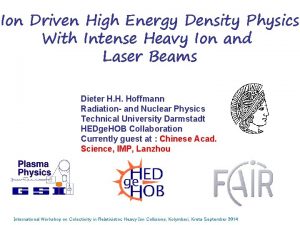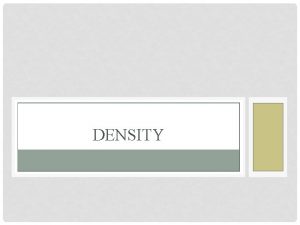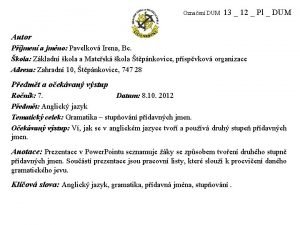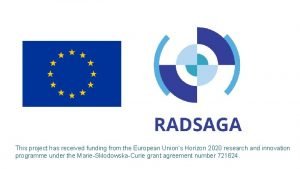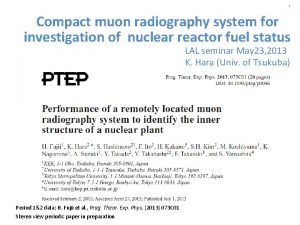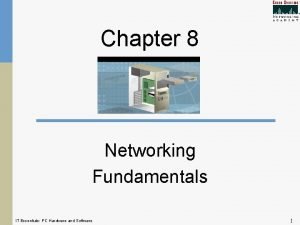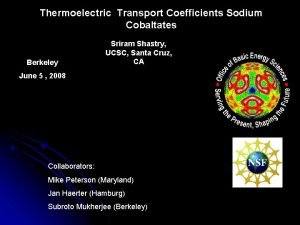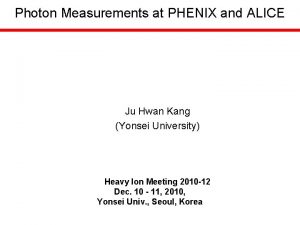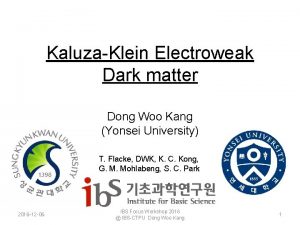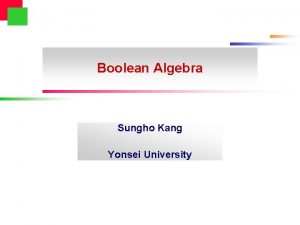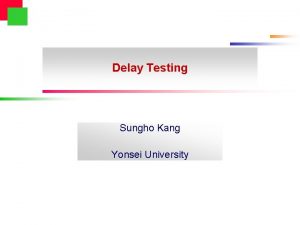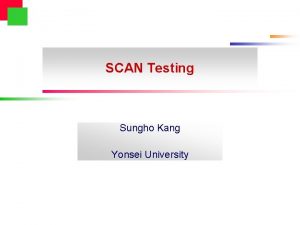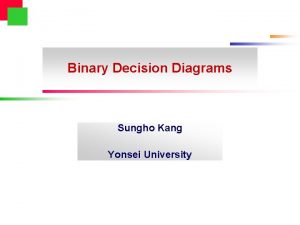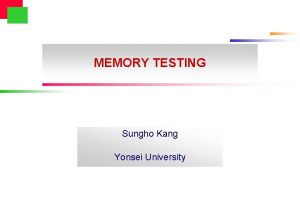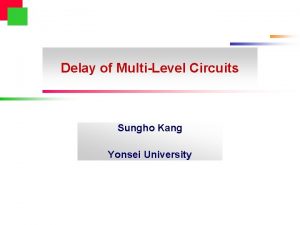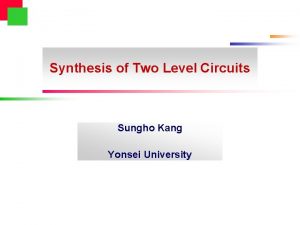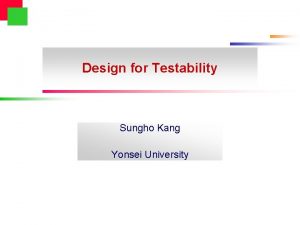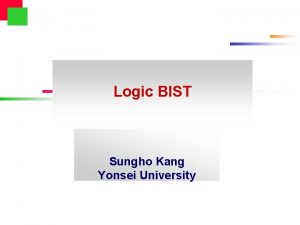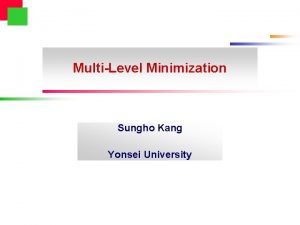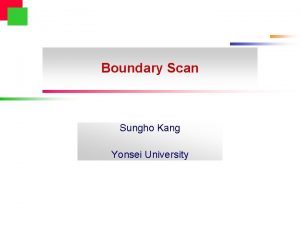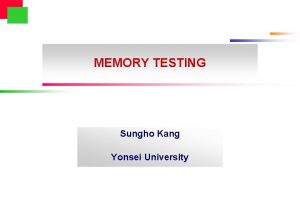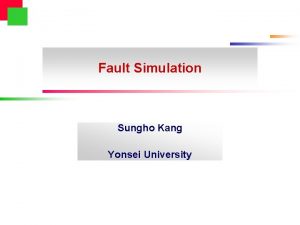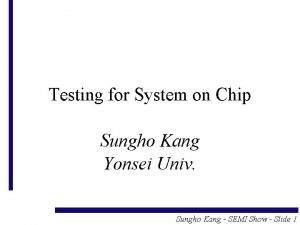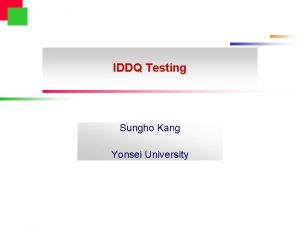ALICE Overview Ju Hwan Kang Yonsei Heavy Ion


























- Slides: 26

ALICE Overview Ju Hwan Kang (Yonsei) Heavy Ion Meeting 2011 -06 June 10, 2011 Korea University, Seoul, Korea

2. 76 Te. V/N Pb-Pb Results Most are extracted from ALICE talks presented at QM 2011 (23 -28 May 2011, Annecy) ð Spectra & Particle Ratios ð Flow & Correlations & Fluctuations ð RAA of inclusive particles ð Heavy open Flavour ð J/Y 2

PID in ALICE Inner tracking system • Low p. T standalone tracker • PID: d. E/dx in the silicon (up to 4 samples) TPC • Standalone and global (+ITS) tracks • PID: d. E/dx in the gas (up to 159 samples) Time of Flight • Matching of tracks extrapolated from TPC • PID: TOF, s. TOT ~ 85 ps(Pb. Pb) – 120 ps(pp) Topological ID + Invariant Mass • Resonances, Cascades, V 0 s, Kinks • PID: indirect cuts to improve S/B π0 -> + -> e+e-e+esimilarly K 0, Λ, Ξ, Ω, . . . 3

p/K/p Spectra Combined analysis in • Inner Tracking System • Time Projection Chamber • TOF p. T Range: 0. 1 – 3 Ge. V/c (p) 0. 2 – 2 Ge. V/c (K) 0. 3 – 3 Ge. V/c (p) Blast wave fits to individual particles to extract yields 4

Comparison to RHIC (0 -5% Central) positive negative fitting spectra & v 2 simultaneously At RHIC: STAR proton data generally not feed-down corrected. Large feed down correction Consistent picture with feed-down corrected spectra STAR, PRL 97, 152301 (2006) At LHC: ALICE spectra are feed-down corrected STAR, PRC 79 , 034909 (2009) • Harder spectra, flatter p at low pt PHENIX, PRC 69, 03409 (2004) • Strong push on the p due to radial flow? 5

Mean p. T increases linearly with mass Higher than at RHIC (harder spectra, more radial flow? ) For the same d. N/dh higher mean p. T than at RHIC 6

Blast wave fits PRC 48, 2462 (1993). Blast wave fits radial flow ~ 10% higher than at RHIC Fit Range: • pions 0. 3 – 1 Ge. V • kaons 0. 2 – 1. 5 Ge. V • protons 0. 3 – 3 Ge. V T depends on the pions and fit-range (effect of resonances to be investigated) 7

Integrated yields ratios p+/p- – p/p All +/- ratios are compatible with 1 at all centralities, as expected at LHC energies K+/KSTAR, PRC 79 , 034909 (2009) 8

Integrated ratios vs Centrality –p/p- STAR (Not feed-down corrected) K-/p- ALICE, BRAHMS, PHENIX (feed-down corrected) Predictions for the LHC p/p: lower than thermal model predictions (1) STAR, PRC 79 , 034909 (2009) PHENIX, PRC 69, 03409 (2004) BRAHMS, PRC 72, 014908 (2005) Ratio Data p/p+ p/p and K/p 0. 0454+-0. 0036 p/p- 0. 0458+-0. 0036 K/p+ 0. 156 +- 0. 012 0. 164 0. 180+0. 001 -0. 001 K/p- 0. 154 +- 0. 012 0. 163 0. 179+0. 001 -0. 001 ratios are 0. 072 very similar 0. 090 at RHIC energies 0. 071 0. 091+0. 009 -0. 007 (1) A. Andronic et al, Nucl. Phys. A 772 167 (2006) T = 164 Me. V, m. B = 1 Me. V (2) J. Cleymans et al, PRC 74, 034903 (2006) T = (170± 5) Me. V and μB =1+4 Me. V

'Baryon anomaly': L/K 0 x 3 Ratio at Maximum RHIC L/K 0 Baryon/Meson ratio still strongly enhanced x 3 compared to pp at 3 Ge. V - Enhancement slightly larger than at RHIC 200 Ge. V - Maximum shift very little in p. T compared to RHIC despite large change in underlying spectra ! 10

Summary – spectra/particle ratio l ALICE has very good capabilities for the measurement of identified particles l Pb. Pb Collision ð Spectral shapes show much stronger radial flow than at RHIC ð p_bar/p ≈ 1. 0 (the state of zero net baryon number) ð p/p ≈ 0. 05 (lower than thermal model predictions with T = 160170 Me. V ) ð Baryon/meson anomaly: enhancement slightly higher and pushed to higher p. T than at RHIC 11

12 Azimuthal Flow: What next ? l Elliptic flow (v 2) and perfect fluid: ð large v 2 => strongly interacting "perfect" fluid ð from hydro: large v 2 => low h => large σ ð h/s = 1/4 p => conjectured Ad. S/CFT limit ð current RHIC limit: h/s < (2 -5) x 1/4 p ð need precision measurement of h/s shear viscosity: l To get precision measurement of h/s (parameters in hydro) using flow vn (experimental data): ð fix initial conditions (geometrical shape is model dependent, eg Glauber, CGC) ð quantify flow fluctuations s (influence measured v 2, depending on method) ð measure non-flow correlations d (eg jets) ð improve theory precision (3 D hydro, 'hadronic afterburner', . . . ) ð. .

Experimental methods y ΨRP z x v 2 {2} and v 2{4} have different sensitivity to flow fluctuations (σn) and non-flow (δ)

14 Non-Flow corrections Elliptic Flow v 2 no eta gap between particles v 2 |h|>1 to reduce non-flow such as jets both v 2 corrected for remaining non-flow using Hijing or scaled pp With this, we can remove most of non-flow (δ) Plane of symmetry (ΨPP) fluctuate event-by-event around reaction plane (ΨRP) => flow fluctuation (σn) v 2 Fluctuations

15 Higher Order Flow v 3, v 4, . . ar. Xiv: 1105. 3865 V 2{2} v 4{2} = <cos(4( 1 - 2))> v 3{2} = <cos(3( 1 - 2))> v 3{4} 4 particle cumulant v 3 relative to reaction & participant planes V 3: small dependence on centrality v 3{4} > 0 => not non-flow v 3{4} < v 3{2} => fluctuations ! v 3{RP} ≈ 0 there should be no “intrinsic” triangular flow, unlike the elliptic flow due to the almond shape of overlapping region

Triangular flow (v 3) – models v 3{4} 4 particle cumulant v 3{2} = <cos(3( 1 - 2))> v 3 relative to reaction & participant planes V 3 measurements are consistent with initial eccentricity fluctuation and similar to predictions for MC Glauber with η=0. 08 16

17 Elliptic Flow v 2 – PID and pt p/K/p v 2 RHIC Hydro predictions PID flow: -p and p are 'pushed' further compared to RHIC - v 2 shows mass splitting expected from hydro

18 Triangular Flow v 3 – PID and pt v 3 for p/K/p v 3 v 4 v 5 versus p. T v 2 p v 3 K p v 4 v 5 Hydro calculation for v 3 energy momentum tensor components for 1 event with b=8 fm (MC Glauber by G. Qin, H. Peterson, S. Bass. and B. Muller) v 3 shows mass splitting expected from hydro (shows different sensitivity to h/s than v 2) also possible to have initial eccentricity fluctuations for square flow v 4 and pentagonal flow v 5

19 Summary – flow • Stronger flow than at RHIC which is expected for almost perfect fluid behavior • First measurements of v 3, v 4 and v 5, and have shown that these flow coefficients behave as expected from fluctuations of the initial spatial eccentricity • New strong experimental constraints on η/s and initial conditions • Flow coefficients at lower pt showing mass splitting are in agreement with expectations from viscous hydrodynamic calculations

20 Charged Particle RAA: Ingredients pp spectrum Pb-Pb 2. 76 Te. V pp reference Measured reference, still needs extrapolation for p. T> 30 Ge. V

charged particle RAA • pronounced centrality dependence below p. T = 50 Ge. V/c • minimum at p. T ≈ 6 -7 Ge. V/c • strong rise in 6 < p. T < 50 Ge. V/c • no significant centrality and p. T dependence at p. T > 50 Ge. V/c 21

charged particle RAA- centrality dependence high p. T: • weak suppression, no significant centrality dependence low p. T: • approximate scaling with multiplicity density, • matching also RHIC results 22

charged particle RAA - models • pronounced p. T dependence of RAA at LHC sensitivity to details of the energy loss distribution 23

charged pion RAA • agrees with charged particle RAA - in peripheral events - for p. T > 6 Ge. V/c • is smaller than charged particle RAA for p. T < 6 Ge. V/c 24

Λ and K 0 s - RCP • K 0 s - RAA very similar to that of charged particles: strong suppression of K 0 s at high p. T • Λ - RAA significantly larger than charged at intermediate p. T: enhanced hyperon production counteracting suppression • for p. T > 8 Ge. V/c, Λ and K 0 s - RAA similar to charged particle RAA: strong high-p. T suppression also of Λ 25

Summary – RAA • Charged particle p. T spectra in Pb-Pb at √s. NN = 2. 76 Te. V measured with ALICE at the LHC • Pronounced p. T dependence of RAA at LHC • Comparison to RHIC data suggests that suppression scales with the charged particle density for a given p. T window • At p. T > 50 Ge. V/c, no strong centrality dependence of charged particle production is observed • Results on identified particles will allow to disentangle the interplay between quark and gluon energy loss, and recombination mechanisms at intermediate p. T 26
 Top heavy bottom heavy asymptotes
Top heavy bottom heavy asymptotes Heavy ion
Heavy ion 7 step sourcing methodology
7 step sourcing methodology Qué son las fuerzas intramoleculares
Qué son las fuerzas intramoleculares Induced dipole induced dipole interaction
Induced dipole induced dipole interaction Ejemplo de fuerza ion ion
Ejemplo de fuerza ion ion Ejemplo de fuerza ion ion
Ejemplo de fuerza ion ion Blake kozeny
Blake kozeny Yonsei university college of nursing
Yonsei university college of nursing Computer science yonsei university
Computer science yonsei university Hyundai heavy industries investor relations
Hyundai heavy industries investor relations How heavy something is for its size
How heavy something is for its size Sac heavy airlift wing
Sac heavy airlift wing Stupňování přídavných jmen angličtina heavy
Stupňování přídavných jmen angličtina heavy Heavy-gauge framing members are manufactured from
Heavy-gauge framing members are manufactured from Heavy duty truck axle repair
Heavy duty truck axle repair Heavy duty cutting of fabric one handle larger than other
Heavy duty cutting of fabric one handle larger than other Heavy ions
Heavy ions Know your knives
Know your knives Superlative heavy
Superlative heavy Heavy object
Heavy object What copper cored cable is surrounded by a heavy shielding
What copper cored cable is surrounded by a heavy shielding Hydraulic machines move heavy loads in accordance with
Hydraulic machines move heavy loads in accordance with What is tornado
What is tornado Gas 101
Gas 101 Mary and lisa
Mary and lisa Heavy fermions
Heavy fermions

